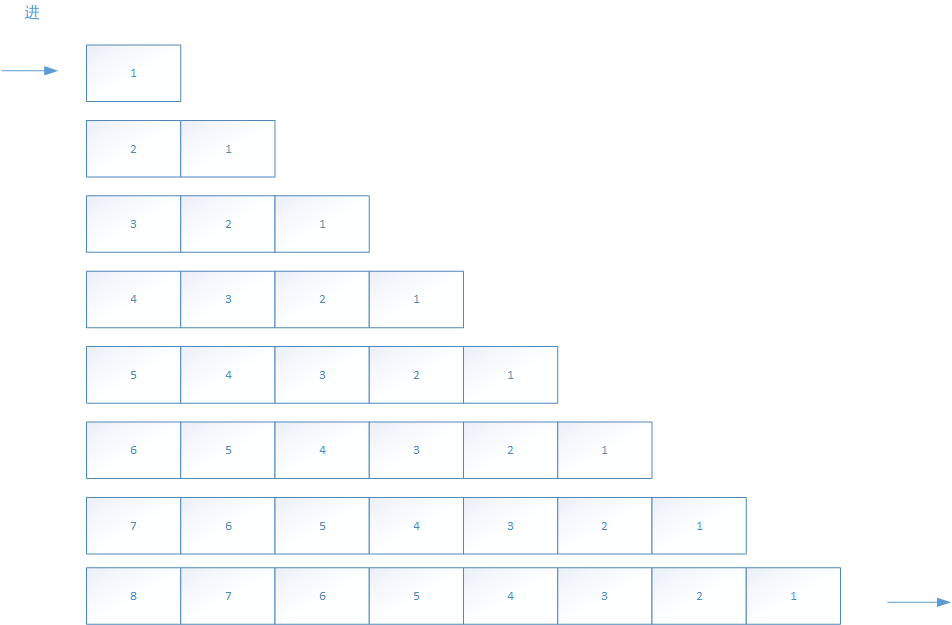前言
学习LinkedList的时候,遇到了队列数据结构,就想着回顾一下队列数据结构。
原理
Queue数据结构是一种线性的结构,先进先出的特性。下面看一下逻辑图

队列在我们写代码的过程比较常用,例如打印日志,一个程序打印日志是比较消耗资源的,一般都会采用队列实现,将需要的日志先放入队列中,由其他线程去
循环队列输出打印。
代码
通过数组实现的定长队列
public class QueueArray<E> { // 定义一个数组 private Object[] data = null; // 记录队列长度 private int size = 0; private int length = 0; private int point = 0; /** * 默认构造函数 */ public QueueArray(){ length = 10; data = new Object[10]; } /** * 自定义队列长度 * @param length */ public QueueArray(int length){ this.length = length; data = new Object[length]; } /** * 往队列里面加入数据 * @param e */ public void push(E e){ data[size++] = e; size = size%length; } /** * 往队列里面获取数据 */ public E pull(){ E e = (E)data[point]; data[point] = null; if(point/length == 1){ point = 0; } else { point++; } return e; } /** * 打印队列 */ public void println(){ for(int i =point ;i < size; i++){ System.out.println(data[i]); } } }
public class QueueTest { public static void main(String[] args) { QueueArray queueArray = new QueueArray(); queueArray.push("1"); queueArray.push(2); queueArray.push("5"); System.out.println(queueArray.pull()); queueArray.push(7); queueArray.push("9"); System.out.println(queueArray.pull()); System.out.println(queueArray.pull()); queueArray.println(); } }
运行结果:

通过链表实现的可变长度队列
public class QueueLinked<E> { /** * 创建内部类链表的节点 * @param <E> */ private class Node<E>{ public E data = null; //数据域 public Node<E> next = null; //指针域 //构造方法 public Node(){} public Node(E data){ this.data = data; } } private Node<E> head = null; //队头 private Node<E> end = null; //队尾 private int size = 0; //队列长度 /** * 判断队列是否为空 * @return */ public boolean isEmpty(){ return size == 0; } /** * 往队列里面加入数据 * @param e */ public boolean push(E e){ Node<E> node = new Node<E>(e); //队列为空的情况下 if(isEmpty()){ this.end = node; //尾节点赋值为新插入的节点 this.head = this.end; //在只有一个节点的情况下,头尾节点相等 size++; return true; } //不为空的情况下 this.end.next = node; //尾节点指向新节点 this.end = node; //更新尾节点 size ++; //队列节点数+1 return true; } /** * 出队 * @return */ public E pop(){ //判断队列是否为空 if(isEmpty()){ System.err.println("队列为空"); return null; } //弹出队头,更新队头指针 Node<E> temp = this.head; //获取队头引用 this.head = this.head.next; //更新队头指针 temp.next = null; //释放原队头节点引用 return temp.data; } /** * 打印数据 */ public void display(){ for (int i = 0; i < this.size; i++) { if(this.head == null){ return; } System.out.println(this.head.data); this.head = this.head.next; } } }
public class LinkedTest { public static void main(String[] args) { QueueLinked queueLinked = new QueueLinked(); queueLinked.push("1"); queueLinked.push(2); queueLinked.push("5"); System.out.println(queueLinked.pop()); queueLinked.push(7); queueLinked.push("9"); System.out.println(queueLinked.pop()); System.out.println(queueLinked.pop()); queueLinked.display(); } }
运行结果:

总结
队列的数据结构,简单的了解一下,写底层C代码才会使用上,平时用不上可惜。